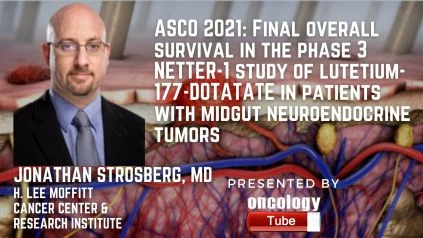Jonathan Strosberg, MD from H. Lee Moffitt Cancer Center & Research Institute speaks about the ASCO 2021 Abstract – Final overall survival in the phase 3 NETTER-1 study of lutetium-177-DOTATATE in patients with midgut neuroendocrine tumors.
Link to Abstract:
https://meetinglibrary.asco.org/record/197214/abstract
Background information:
The most prevalent intraocular cancer, ocular melanoma, commonly metastasizes to the liver, yet there is no clear standard of therapy for individuals with hepatic-dominant ocular melanoma. The FOCUS study began as a phase III randomized experiment (301) that compared PHP to the best alternative care (BAC). Due to enrollment issues, the study was later altered (301A) to exclude the BAC arm.
Methodologies:
The 301 study randomized eligible patients with hepatic dominant ocular melanoma to receive PHP or BAC (investigator’s choice of TACE, pembrolizumab, ipilimumab, or dacarbazine). On the 301A study, all eligible patients got PHP. PHP patients might undergo up to 6 PHP treatments, with melphalan dosed at 3.0 mg/kg ideal body weight, repeated every 6-8 weeks (IBW). Patients with progressing disease (PD) were removed from the trial, and all patients were tracked until they died. Patients were photographed every 12 (two) weeks until they developed Parkinson’s disease. The point estimate and 95 percent confidence interval for each group will be used to describe the primary endpoint, ORR (per RECIST 1.1) as reviewed by the Independent Review Committee (PHP and BAC). The frequency counts and percentages, as well as the 95 percent confidence intervals, for categorical effectiveness factors, will be reported. Kaplan-Meier techniques will be used to summarize time-to-event variables (median and 95 percent CI).
The following are the outcomes:
Overall, 144 patients were recruited, with 102 allocated to PHP (301: n=43; 301A: n=59) and 42 to BAC. A total of 91 PHP patients (301: n=40; 301A: n=51) and 32 BAC patients were treated. Four PHP patients remained on study therapy with a minimum follow-up of 24 weeks at the time of this analysis. The response was assessed in 79 PHP-treated patients and 29 BAC-treated individuals. The ORR was 32.9 percent (26/79; 95 percent CI: 22.75-40.40 percent) in PHP patients. The ORR for BAC patients was 13.8 percent (4/29; 95 percent confidence interval: 3.89-31.66%). The median PFS for PHP patients was 9.03 months (95 percent confidence interval: 6.24-11.83) compared to 3.06 months (95 percent confidence interval: 2.69-5.65) for BAC patients; this difference was statistically significant (p=0.0004). 40.4 percent of the 94 patients who were examined for safety after receiving PHP had a significant treatment-emergent adverse event, the majority of which were hematological and cleared without complications. In the trial, no one died as a result of the therapy.
Final Thoughts:
PHP had a statistically higher ORR and considerably longer PFS than BAC in the treatment of hepatic metastases from ocular melanoma, according to this analysis of early data from the FOCUS study. The findings are encouraging since effective therapies for ocular melanoma hepatic metastases are critically needed. These preliminary results demonstrate that employing second-generation filters, effectiveness (ORR and PFS) as well as toxicity have improved over the prior phase III trials.
NCT02678572 is the number for the clinical study.

